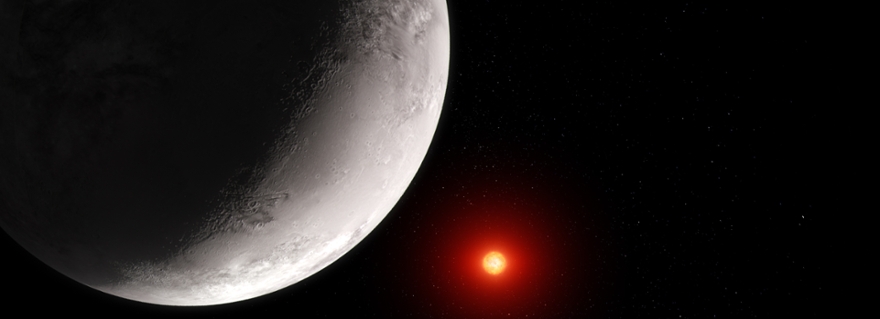
To look for atmospheres around planets outside our solar system is to look for extraterrestrial life. Astronomist Sebastian Zieba used data from the James Webb Space Telescope to study small rocky exoplanets but found no aliens yet. However, his findings are still very interesting for future observations. Zieba graduated cum laude on 25 June.
'The holy grail is always to find traces of life', Sebastian Zieba says, affiliated with Max Planck Institute for Astronomy (MPIA) in Heidelberg and Leiden Observatory. 'But we're not yet able to detect some form of life directly.' We need to figure out what planets besides the Earth are good hosts for atmospheres, and by extension, life. That's what Sebastian's research encompasses: searching for atmospheres around rocky exoplanets. These are planets outside our solar system that are smaller than two times the radius of the Earth and dominated by rock.
Really hot planet
To detect a possible atmosphere around an exoplanet you could measure the temperature of the planet. This gives some insight into the climate and heat transport. Zieba used this technique while observing K2-141 b, a lava planet that's incredibly close to its host star. Because of the high gravitational forces between the planet and the star this planet always shows the same side to its host star. As a result, one side is completely molten and the other side is very cold. Due to the extreme temperatures, rock starts evaporating, which might create a rock vapour atmosphere. That is why Zieba wanted to study this planet.
'What we tried to answer was: is the planet really hot or somewhat colder than really hot?'
An atmosphere could redistribute the heat from the hot side to the cold side, making it slightly less cold on the night side and less hot on the day side. Zieba: 'What we tried to answer was: is the planet really hot or somewhat colder than really hot?' Zieba was able to find some sign of a rock vapour atmosphere. New data from the James Webb Space Telescope (JWST) should give more insights into these types of exoplanets.
Venus-twin is bare rock
You can also study the emission spectra in search for specific molecules, suggesting the presence of an atmosphere. Zieba observed the spectra of TRAPPIST-1 c, another rocky exoplanet that is quite similar to Venus. 'That motivated us to think the atmosphere would be similar as well.' He searched for traces of carbon dioxide (CO₂). Why CO₂? 'CO₂ is everywhere. Any activity on a planet, such as volcanism, would cause an amount of CO₂. So if there is an atmosphere, you would expect to find a certain amount of CO₂. But we did not find any CO₂ on this planet.' TRAPPIST-1 c is likely a bare rock planet and nothing like Venus with its thick CO₂-rich atmosphere.
Working with JWST data
Zieba started off using Spitzer, another infrared telescope, but during his PhD, was able to use data from the James Webb Space Telescope (JWST). 'I feel honoured to belong to the first generation of PhD students who get to work with the JWST data.'
Better telescopes might enable further research into the atmospheres of exoplanets. 'It would be awesome to launch ten JWSTs and then glue them together', he jokingly comments. Zieba is looking forward to working with JWST in the future, as well as some other projects that are currently under construction (Extremely Large Telescope in Chile) or in the design phase (Habitable Worlds Observatory and the LIFE space mission).
There is always something to learn
Despite not detecting any atmosphere around one of the observed exoplanets, Zieba's research is rather valuable nonetheless. 'If you don't detect some feature in an object, such as an atmosphere, it is possible that it doesn't exist, but it can also be due to additional noise, from either the star or your instrument. You will always learn more for future observations, even if we don't find an atmosphere or another hint towards life.'
Major step forward
Zieba's supervisor and director at MPIA Laura Kreidberg about his work: 'It is a major step forward in our understanding of rocky exoplanets. His finding about the atmosphere of TRAPPIST-1 c is the first indication of the potential diversity in the atmospheres of small worlds beyond the Solar System.' Ignas Snellen, scientific director of the Leiden Observatory and second promoter of Zieba adds: 'He has achieved one of the most significant results in our field in recent years.
Sebastian Zieba defended his doctoral thesis titled 'Pushing the Characterization of Exoplanet Atmospheres Down to Temperate Rocky Planets in the Era of JWST'






